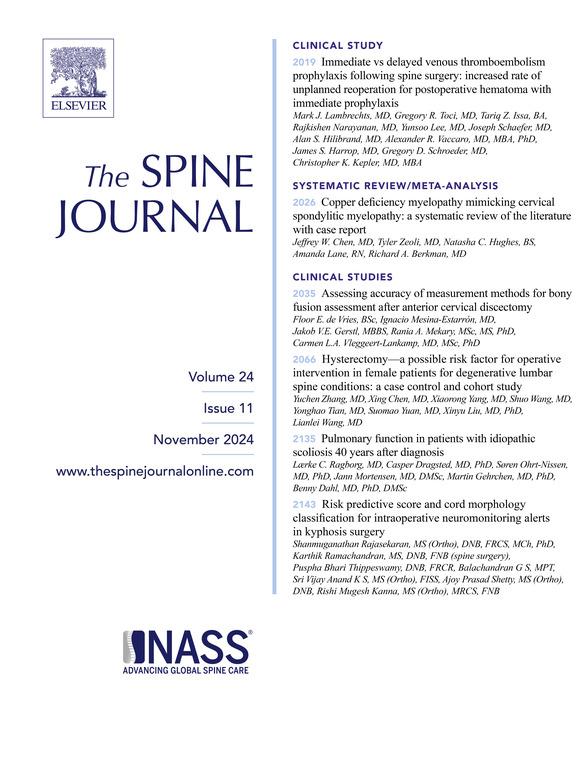64. 腰4-骶骨融合后复制预融合坐姿可能会导致上腰椎活动受限的患者关节段断裂
IF 4.7
1区 医学
Q1 CLINICAL NEUROLOGY
引用次数: 0
摘要
背景:在我们之前对健康成人的放射学研究中,我们观察到从站立到坐姿的转变与腰椎前凸的消失有关。骶骨变得更加垂直,导致骶骨斜率显著降低。L4-S1前凸减小幅度最大(28.8°至17.4°,p < 0.01)。在接受L4-S1固定融合术的患者中,近端活动节段可能在从站立到坐姿的转变过程中得到恢复,以补偿下腰椎活动能力的丧失。这可能使近端节段承受超生理屈曲负荷。目的:在本研究中,我们的问题是:在L4-S1融合后,为了使受试者能够复制融合前的坐姿,必须进行哪些对齐改变?目标是成功恢复L1的矢状位和角取向(L1 SVA和L1斜率)到融合前坐姿的值,因为这将确保融合后胸椎和颈椎的对齐将保持在融合前坐姿的对齐附近。研究设计/设置对站立和坐姿的EOS x线摄影图像进行受试者特定的运动学分析。患者样本:10名健康志愿者。结果测量:矢状面对齐参数:L1 SVA和L1斜率。方法通过分析10例健康志愿者站立和坐姿的全身EOS x线图像,评价其骶椎矢状位排列。接下来,我们使用受试者特定的运动学分析来研究近端活动腰椎节段(L1-L4)为弥补L4-S1融合导致的屈曲运动损失所必需的角度补偿。然后我们评估了在L1- l2、L2-L3和L3-L4节段之间分配角运动的各种策略,这些策略将允许L1椎体返回其矢状位置和角方向,以匹配融合前的坐姿。结果在模拟l4 -骶骨融合后,需要更大的L1-L4屈曲来复制融合前的坐姿:融合后屈曲13°与融合前屈曲2°(p < 0.01)。试图将L1的矢状位和角度对齐恢复到融合前的值,需要在L4-S1融合附近的L3-L4节段进行更多比例的运动补偿,而不是更近端的腰椎水平。尽管在L3-L4关节段发生了所有运动补偿,但L1 SVA的残差仍为11±5.0 mm。结论:我们模拟了一个场景,融合后坐姿只能通过剩余活动腰椎节段的代偿运动来实现。在体内,除了尝试腰椎内的部分代偿外,患者还可以选择改变其融合后的坐姿。患者的这些行为可能会减轻本研究预测的结膜负担。值得注意的是,与腰椎近端水平相比,试图恢复L1椎体矢状位和角对齐到融合前坐姿时的值会增加L3-L4节段交界处的代偿负担。这种运动补偿模式需要L1处的净前切力(由肌肉协同激活或椅背支撑引起),这会导致远端比近端增加弯曲力矩。为了使融合后患者能够复制融合前的坐姿,对关节节段的代偿性屈曲运动需求增加,这可能导致上腰椎活动受限的患者相邻节段破裂。FDA器械/药物状态本摘要不讨论或包括任何适用的器械或药物。本文章由计算机程序翻译,如有差异,请以英文原文为准。
64. Replicating prefusion sitting posture following L4-sacrum fusion may cause junctional segment breakdown in patients with limited upper lumbar mobility
BACKGROUND CONTEXT
In our previous radiographic study of healthy adults, we observed that a transition from standing to sitting was associated with a loss of lumbar lordosis. The sacrum became more vertical, causing a significant reduction in the sacral slope. The greatest reduction in lordosis was at L4–S1 (28.8° to 17.4°, p<0.01). In patients who undergo instrumented fusion of L4-S1, the proximal mobile segments may be recruited during this transition from standing to sitting to compensate for the loss of lower lumbar mobility. This may subject proximal segments to supra-physiological flexion loading.
PURPOSE
In this study, we asked: what alignment changes must take place post L4-S1 fusion, to allow the subject to replicate the prefusion sitting posture? Successful restoration of the sagittal position and angular orientation of L1 (L1 SVA and L1 slope) to their values in the pre-fusion sitting posture was the goal as that would ensure that the postfusion alignments of the thoracic and cervical spine would be maintained as near their alignments in the prefusion sitting posture.
STUDY DESIGN/SETTING
Subject-specific kinematic analysis of standing and sitting EOS radiographic images.
PATIENT SAMPLE
Ten healthy volunteers.
OUTCOME MEASURES
Sagittal alignment parameters: L1 SVA and L1 slope.
METHODS
Lumbosacral sagittal alignments in standing and sitting postures were assessed by analyzing full-length EOS radiographic images of 10 healthy volunteers. Next, we used subject-specific kinematic analysis to investigate the angular compensation that would be necessary in the proximal mobile lumbar (L1-L4) segments to make up for the flexion motion lost secondary to L4-S1 fusion. We then evaluated various strategies to distribute the angular motion amongst L1-L2, L2-L3, and L3-L4 segments that would allow the L1 vertebra to return to its sagittal position and angular orientation to match the pre-fusion sitting posture.
RESULTS
Following simulated L4-sacrum fusion, significantly greater L1-L4 flexion was required to replicate the pre-fusion sitting posture: 13° flexion postfusion vs 2° flexion pre-fusion (p<.01). Attempts to restore both the sagittal position and angular alignment of L1 to their pre-fusion values required an increasing proportion of motion compensation to occur at the L3-L4 segment adjacent to L4-S1 fusion compared to more proximal lumbar levels. Residual L1 SVA mismatch of 11±5.0 mm persisted despite all motion compensation occurring at the L3-L4 junctional segment.
CONCLUSIONS
We simulated a scenario in which postfusion sitting posture was achieved only through compensatory motions within the remaining mobile lumbar segments. In vivo, a patient may choose to alter his/her postfusion sitting posture in addition to attempting partial compensation within the lumbar spine. Such actions on the part of the patient will likely reduce the junctional burden predicted in the current study. Notably, attempts to restore both the sagittal position and angular alignment of the L1 vertebra to their values in prefusion sitting posture put increased compensatory burden on the junctional L3-L4 segment as compared to more proximal lumbar levels. Such motion compensation pattern requires a net anterior shear force at L1 (caused by muscle coactivation or a chairback support) that would cause increased flexion moment distally than proximally. The increased compensatory flexion motion demand on the junctional segment to allow the postfusion patient to replicate prefusion sitting posture may lead to adjacent segment breakdown in patients with limited upper lumbar mobility.
FDA Device/Drug Status
This abstract does not discuss or include any applicable devices or drugs.
求助全文
通过发布文献求助,成功后即可免费获取论文全文。
去求助
来源期刊

Spine Journal
医学-临床神经学
CiteScore
8.20
自引率
6.70%
发文量
680
审稿时长
13.1 weeks
期刊介绍:
The Spine Journal, the official journal of the North American Spine Society, is an international and multidisciplinary journal that publishes original, peer-reviewed articles on research and treatment related to the spine and spine care, including basic science and clinical investigations. It is a condition of publication that manuscripts submitted to The Spine Journal have not been published, and will not be simultaneously submitted or published elsewhere. The Spine Journal also publishes major reviews of specific topics by acknowledged authorities, technical notes, teaching editorials, and other special features, Letters to the Editor-in-Chief are encouraged.
 求助内容:
求助内容: 应助结果提醒方式:
应助结果提醒方式:


